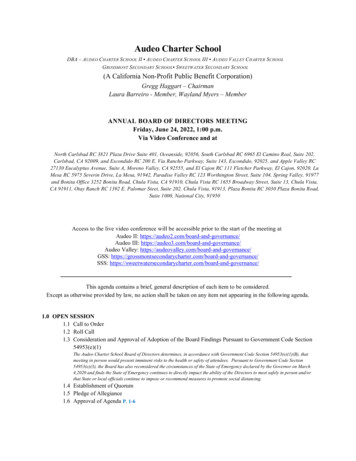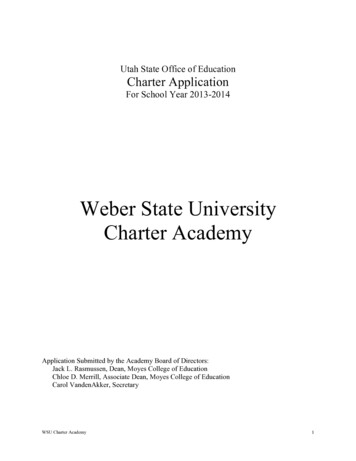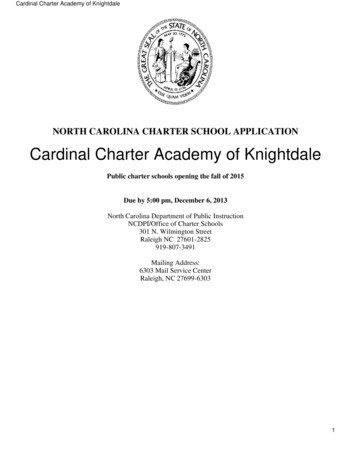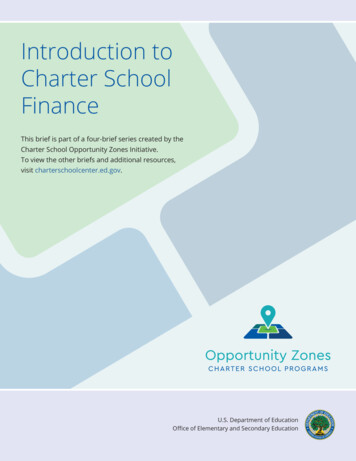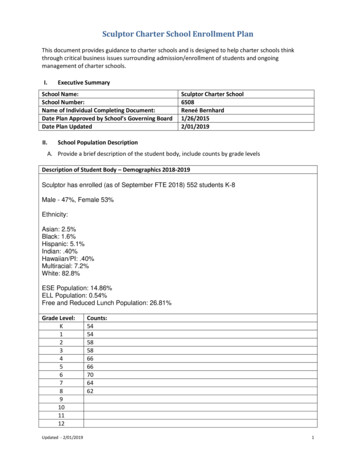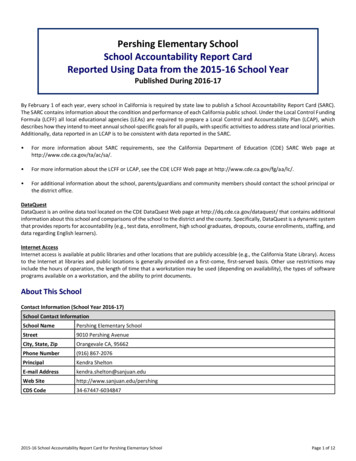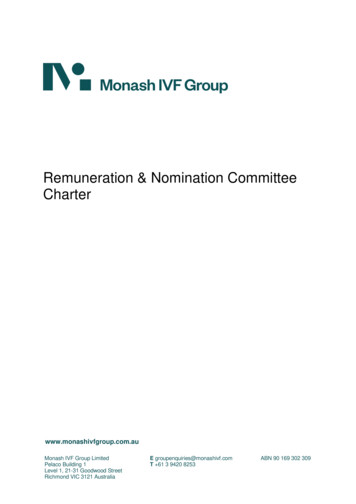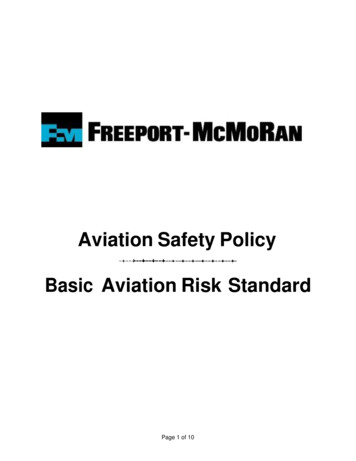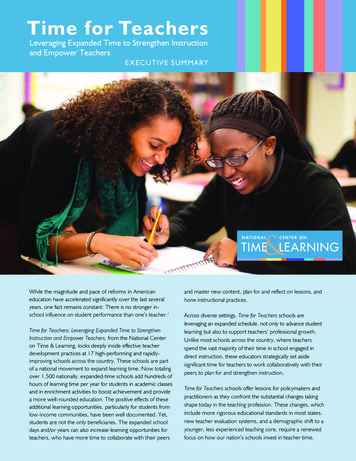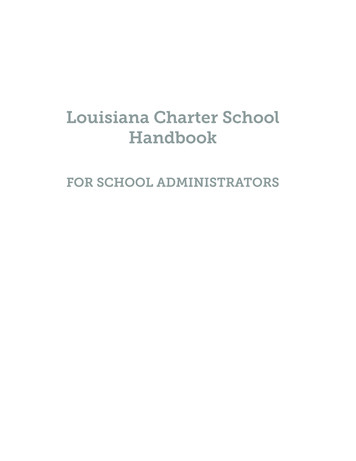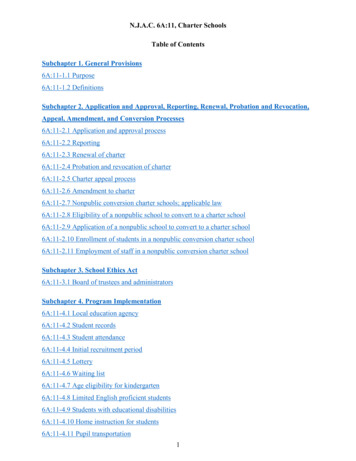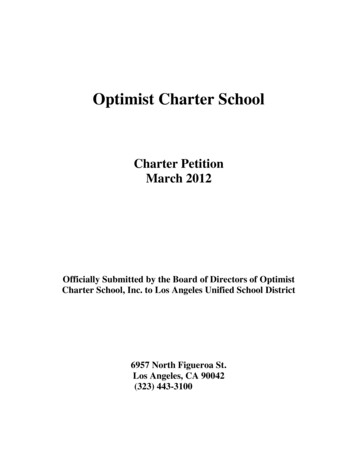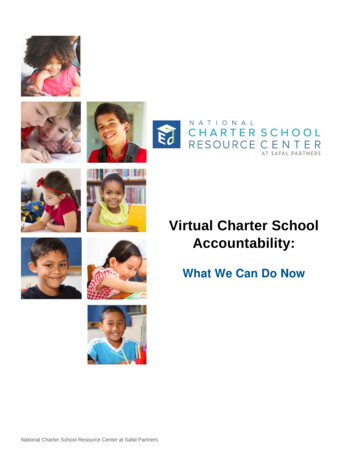
Transcription
Virtual Charter SchoolAccountability:What We Can Do NowNational Charter School Resource Center at Safal Partners
Virtual Charter School Accountability: What We Can Do NowThe National Charter School Resource Center (NCSRC) is dedicated to supporting the development ofhigh-quality charter schools. The NCSRC provides technical assistance to sector stakeholders and has acomprehensive collection of online resources addressing the challenges charter schools face. The websitehosts reports, webinars, and newsletters focusing on facilities, funding opportunities, authorizing, Englishlearners, special education, military families, board governance, and other topics. The NCSRC is funded bythe U.S. Department of Education and led by education consulting firm Safal Partners.National Charter School Resource Center (http://www.charterschoolcenter.ed.gov/)Safal Partners is a mission-driven strategy consulting firm that supports education reform efforts at thefederal, state, district and school levels.Safal Partners (http://www.safalpartners.com/)The National Association of Charter School Authorizers (NACSA, http://www.qualitycharters.org/) is anindependent voice for effective charter school policy and thoughtful charter authorizing practices that leadto greater public schools.AuthorsNelson Smith, Elisa WestapherAcknowledgmentsThe authors wish to thank those involved in the production of this report: Stefan Huh and Soumya Sathyaof the U.S. Department of Education for guidance and feedback; Mukta Pandit for her leadership as ProjectDirector; Safal Partners for editing and design; Lyria Boast of Public Impact for her research and analysis;and members of the virtual charter school oversight working group 1, which provided valuable insights andperspectives.This toolkit was produced under U.S. Department of Education Contract No. ED-OII-13-C-0065 with SafalPartners, Inc. Soumya Sathya served as the contracting officer’s representative. The content of thepublication does not necessarily reflect the views or policies of the U.S. Department of Education, nor doesmention of trade names, commercial products, or organizations imply endorsement by the U.S.Government. This toolkit is in the public domain. While permission to reprint this publication is notnecessary, it should be cited as:Smith, N. and Westapher, E. (2017). Virtual Charter School Accountability: What We Can Do Now.National Charter School Resource Center at Safal Partners2
Virtual Charter School Accountability: What We Can Do NowTABLE OF CONTENTSIntroduction“Virtual” DefinedA Sketch of the Virtual SectorEvidence and Pushback on PerformanceDeveloping a Common LanguageApproving Virtual Charter SchoolsPast PerformanceKey QuestionsMarketingKey QuestionsEnrollment and Student and Family OnboardingReadiness to OpenContractsPrimacy of CharterManagement AgreementsKey QuestionsMonitoring and OversightAttendance, Engagement, and Instructional TimeTeacher-Student Rations and Contract TimeAccountability for OutcomesBegin and Standard MetricsKey Questions About Accountability MetricsGraduation Rates/CohortsKey Questions About Graduation RatesTesting Formats and TimingClarifying “Mobility”Intervention, Renewal, and RevocationNew Skills NeededConclusionEndnotesNational Charter School Resource Center at Safal Partners3
Virtual Charter School Accountability: What We Can Do NowINTRODUCTIONVirtual charter schools educate about 180,000 students in 23 states.2 That is a small sector within thecharter movement, where students now number nearly three million, and a drop in the bucket compared tothe 50 million students in K-12 schools countrywide. However, virtual charter school enrollments have beengrowing fast in some states. Many parents view the virtual option as a godsend—especially in cases wheretheir children have failed to thrive in more traditional environments.Yet virtual charter schools occupy a disproportionate share of education news, due mostly to a series ofadverse reports on poor academic performance coupled with some distressing cases of fraud.Charter authorizers—the bodies that grant and oversee charters and make high-stakes decisions aboutwhether to renew them—have been struggling to work their way through this thicket of discouraging news.When authorizers apply to virtual charter schools the same level of accountability that similar performancewould merit in other kinds of charter schools, they are often met by lawsuits and political pressure to keepthe virtual schools open.The National Association of Charter School Authorizers (NACSA) joined in 2016 with the National Alliancefor Public Charter Schools (NAPCS) and the reform group 50CAN to issue a call for tougher oversight ofvirtual charter schools, including closure for those that chronically underperform, in response to reports bythe Center for Research on Educational Outcomes (CREDO) at Stanford University, other researchorganizations, and state education agencies, all showing discouraging outcomes for students in virtualcharter schools. Evidence shows that virtual charter schools enroll large numbers of students who areunlikely to benefit from self-directed online pedagogy, which led the three organizations to raise thepossibility that states might continue to offer virtual schooling but not under the charter banner. This wouldenable the virtual schools to be more selective than is permissible under open-enrollment laws that governpublic charter schools.This paper, produced by NACSA for the National Charter School Resource Center, serves a more directand limited purpose than the 2016 manifesto. This paper deals with the world as it is, and intends to givestate education agencies (SEAs) and the authorizers in their states the tools and perspectives needed toprovide better-informed and more effective oversight right now. SEAs and authorizers should hold virtualcharter schools to the same high standards as other public schools; however, virtual charter schools doraise unique questions about accountability. This paper provides recommendations for the specific oversightof virtual charter schools.This paper draws on research compiled for 2016 report, plus additional findings developed for this projectby Public Impact. NACSA produced the report in consultation with a working group of SEA officials andcharter authorizers, several of whom have personal experience in the virtual sector. Additionally, NACSAconsulted with operators of virtual charter schools and held numerous conversations about virtual schoolingat education reform conferences and in other informal venues.“VIRTUAL” DEFINEDTo be clear from the outset, this paper is not about all schools that use extensive technology, charters thatuse computers to encourage self-directed learning, or the so-called “blended” or “hybrid” charter modelsthat combine online experiences with classroom-based, brick and mortar education. It is about full-timevirtual schooling delivered under a charter contract granted by a state-endorsed authorizer. This is anNational Charter School Resource Center at Safal Partners4
Virtual Charter School Accountability: What We Can Do Nowimportant distinction since the vast majority of students in full-time virtual schools are in charter schools. 3Most virtual or “distance learning” in other contexts is used for credit recovery, enrichment, or courseworknot offered in a particular public-school setting.CREDO’s national online charter school study provides a definition of an “online school” that fits well in thissituation: “an online school is a school which provides the majority of classes (everything except PE, band,or a similar elective) to full-time students through a computer via the internet. Lessons may be synchronousor asynchronous. Lessons may consist of videos, live chat, bulletin boards, or any other common means ofelectronic communication. But the primary delivery method must be online.” 4A SKETCH OF THE VIRTUAL SECTORAs the chart below indicates, enrollment in full-time virtual charter schools has risen sharply since the turnof the century. Because eight of the current 44 chartering jurisdictions (43 states and the District ofColumbia) do not allow full-time virtual charter schools, there is an uneven distribution of that growth. Threestates—Ohio, Pennsylvania, and California—now account for more than one-half of all virtual schoolenrollments. 5One reason for this concentration is the sheer size of some virtual charter schools. Although there are manysmaller virtual charters serving students in certain districts, most states allow these schools to drawenrollment statewide. Two national companies, Connections and K12, manage high-enrollment charters ina number of states. K12’s Ohio Virtual Academy currently enrolls just under 10,000 students andCommonwealth Connections Academy in Pennsylvania has over 9,000 students. 6Figure 1: Number of Online Charter Schools Operating by State, with Statewide StudentEnrollments7Only six states—Florida, Minnesota, New Mexico, North Carolina, Ohio, and Pennsylvania—require virtualcharters to have a physical presence (a brick and mortar location), but that may simply mean administrativeoffices. 8 Fourteen states have limits to growth on the books, but according to The Center on ReinventingPublic Education (CRPE), restrictions on enrollment do not necessarily correspond to low enrollmentNational Charter School Resource Center at Safal Partners5
Virtual Charter School Accountability: What We Can Do Nownumbers.” 9 For-profit education management organizations (EMOs) operate about 70 percent of full-timevirtual charters, compared to just 15 percent of all charters. 10 Even though virtual charter schools remain arelatively small sector of public schooling, their statewide scale produces the kind of revenues that makefor a significant lobbying presence in state capitols. K12 alone spent 1.25M lobbying in Pennsylvaniabetween 2007 and 2015, nearly a third of what the state teachers’ union spent in that period. 11Figure 2: Enrollment in Full-Time Virtual Schools 12Virtual operators have been involved in a variety of legal skirmishes in recent years. After the OhioDepartment of Education’s (ODE’s) early-2016 investigation revealed potential shortcomings in attendanceand ODE asked for login records, ECOT went to court arguing that its original 2003 contract only called fordocumentation that students were provided the state-required 920 hours of “learning opportunities,” not thatstudents were actually engaged in learning during that time. 13However, a judge in Ohio, who noted that the 2003 contract applied only for the 2002 and 2003 fundingreviews, rejected that argument. The judicial opinion further stated that “if the funding agreement wereinterpreted in the manner that ECOT suggests, to require the state to continue paying hundreds of millionsof dollars per year without any ability to determine whether students are in fact participating in any curriculumat ECOT at all” would be a violation of public policy. 14 While Ohio’s Supreme Court is set to hear the casein February 2018, ECOT closed its doors on January 19, 2018, citing financial distress after failing to reachan agreement with ODE, which has been deducting about 4 million per month to recover overpayments tothe school based on revised, but disputed, enrollment counts. 15This is a textbook illustration of why precise language is important in determining what counts as evidencefor critical metrics such as attendance and engagement. Authorizers and operators need a crystal-clearunderstanding of measurement and reporting requirements, particularly if state law is vague. (See“Monitoring and Oversight” below.)National Charter School Resource Center at Safal Partners6
Virtual Charter School Accountability: What We Can Do NowEVIDENCE AND PUSHBACK ON PERFORMANCEAfter more than a decade of largely unexamined growth, the virtual charter sector is now the subject ofintense scrutiny by researchers and policymakers. It is hard to find good news about any virtual charterschool in the recent spate of third-party evaluations.Monitoring & OversightIn July 2016, California attorney general Kamala Harris announced settlement of claims against CaliforniaVirtual Academies (CAVA) and K12, the national virtual provider that manages its 14 affiliated schools. Theattorney general stated that “K12 and the CAVA Schools it operates in California misled parents to inducethem to enroll their children in K12 schools by publishing misleading advertisements about students’academic progress, parent satisfaction, their graduates’ eligibility for University of California and CaliforniaState University admission, class sizes, the individualized and flexible nature of their instruction, hiddencosts, and the quality of the materials provided to students.”16Another point of contention was the alleged inflation of attendance counts. The settlement requires K12 toimplement new procedures regarding student attendance and active participation. Teachers will be requiredto evaluate whether students are actually engaged in learning, not merely logging on. Further, “learningcoaches”—often parents— will be required to submit logs for off-line activities including.” 17Under the settlement, K12 agreed to provide approximately 160M in debt relief to the schools. The attorneygeneral contends that the firm had overloaded the schools with so-called “balanced budget credits” underthe fee structure K12 uses in its contracts and will pay 8.5M in settlement of all claims 18 are a means ofkeeping the schools solvent. According to one authorizer, the firm explained that the company “providesservices to the charter school, and then forgives the charges each year in the form of ‘K12 Balanced BudgetCredits.’ The amount forgiven is equal to the school’s spending deficit, allowing the school budget to zeroout.”19K12 CEO Stuart Udell said the credits are “the difference between K12’s contractual price and what theschools can afford to pay” based on their state funding and that the settlement mischaracterizes paymentas “debt relief.” “While K12 has a contractual right to recover these balanced budget credits, in all the yearsthat K12 has worked with the CAVA boards we have never sought to recover those amounts.”20NACSA became directly engaged in this search for good news after the Georgia Charter SchoolsCommission sought national benchmarks of virtual charter performance, knowing that schools in their ownportfolio were in danger of non-renewal based on unacceptable academic results. With funding from theCommission, NACSA and Public Impact conducted a literature search, which included two national studiespublished in 2015; evaluations by state agencies including Colorado, Wisconsin, Georgia, Minnesota, andWashington; university-based researchers at Georgia State, Stanford, Harvard’s Kennedy School ofGovernment, and the University of Arkansas; and reports published by news outlets. The report concludedthat after looking at proficiency, growth, performance on state accountability measures, and graduation anddropout rates, virtual charter performance is “lackluster” and the researchers were unable to find any virtualschool consistently producing strong academic results. 21National Charter School Resource Center at Safal Partners7
Virtual Charter School Accountability: What We Can Do NowLater in 2015, three major research organizations—CREDO, Mathematica, and CPRE—issued reports withthe same bleak theme. Drawing on data from 17 states and the District of Columbia, and using a “virtualtwin” approach that matches students with their counterparts in a traditional school on observabledemographic measures and prior academic performance, CREDO produced the striking conclusion that onaverage, “online charter students have much weaker growth overall.” Across all tested students in onlinecharters, the typical academic gains for math are -0.25 standard deviations (equivalent to 180 fewer daysof learning) and -0.10 (equivalent to 72 fewer days) for reading. 22In August 2016, the Thomas B. Fordham Institute, using a different methodology, examined theperformance of Ohio virtual charter schools and reported, “Across all grades and subjects, students whoattend e-schools perform worse on state tests than otherwise-similar students who attend brick-and-mortardistrict schools, even accounting for prior achievement.” 23Meanwhile, virtual charters are starting to run into state laws requiring mandatory closure for chronicallypoor performance on state accountability ratings. Indiana’s statute requires authorizers to close chartersscoring an F on the state accountability system for three consecutive years. In 2016, the Indiana StateBoard of Education questioned why Ball State University was arguing for renewal of Hoosier AcademyVirtual after five consecutive F grades, but delayed judgment pending another year of results. 24 The school’sboard subsequently voted to close the school at the end of the 2017-18 school year rather than apply forrenewal. 25It will come as no surprise that operators of virtual charters are challenging this barrage of bad news. Thoseinterested in the technical arguments made by operators and researchers can find online the statements byK12, CREDO 26 , the National Education Policy Center 27 , and other groups that participated in recentcolloquies. 28 A brief summary of operator contentions includes the following: Performance has improved since CREDO and others collected data for their reports. Operators citethe strong growth results in Ohio’s 2016 state grades, which improved dramatically after the statedecided to base the calculation only on two years of consecutive tests in the same virtual school—that is, not including a student’s first year after transferring to the virtual school in the calculation. The negative CREDO results are based on a methodology that does not take into account studentswho enroll late (even up to a week before testing), or the unquantified factors for which parentschoose to enroll their children into online charter schools. However, it should be noted that CREDOdid directly address mobility and found that mobility rates are lower before students enter virtualschooling, and higher after they leave. 29 Operators have taken steps to improve. K12 notes that it now publishes detailed annual reports onacademic progress and is implementing parent-training programs. Likewise, Connections reportsthat it has rewritten its math curriculum in response to the fact that overall math performance is anissue, and has started to see improvements in student performance. Four-year graduation cohorts are meaningless when students enroll throughout high school and areoften significantly credit-deficient.For SEAs and authorizers, arguments about accountability metrics raise more questions than they settle.For example: If states have determined that the key metrics for school accountability are annual reading and mathscores, why should these not apply equally to virtuals? Are there additional valid and reliable measures that make sense for these schools?National Charter School Resource Center at Safal Partners8
Virtual Charter School Accountability: What We Can Do Now Should authorizers consider the range of parent motivations for enrolling students in virtual charters? How should the type and duration of student mobility affect the accountability equation? Or, is the“mobility” of a star athlete who studies virtually during the season the same as the “mobility” of astudent whose impoverished family has been evicted twice in the past year? Should schools be excused from accountability when they enroll high numbers of studentsexperiencing difficulty in other classroom settings, or should the elements of accountability bedifferent for them? Should authorizers create separate performance frameworks for virtual charter schools? How much should states and authorizers think carefully about “input” measures, such as attendanceand engagement, in self-paced models oriented to mastery of content instead of seat-time?DEVELOPING A COMMON LANGUAGEToo much of the dialogue between authorizers and operators regarding these questions often happens afterthe fact. Virtual charters are falling far short on available, observable measures of performance. Whenauthorizers call them to task for poor performance, operators contend that the required metrics are wrong,and their students have unique challenges. When authorizers ask for documentation of these challenges,operators have difficulty producing the kind of hard evidence required for high-stakes decisions.This conversation needs to start with an agreed-upon set of metrics, both conventional and non-standard,that authorizers can use to evaluate performance. Agreement about metrics should take place within theinitial charter approval process, during the early goal-setting stages of the charter, and at every subsequentrenewal—not after the authorizer has already called the charter status into question.NACSA encourages authorizers to create performance frameworks for all charter schools that spell outmetrics and goals in three areas: academics, finance, and organizational compliance. As important as theseframework metrics and goals are for schools with traditional learning models, they are crucially importantfor schools with non-traditional models, such as “alternative” schools that serve former dropouts, studentswith a history of substance abuse, or chronic truants.Virtual Charter School ApplicantsThe Georgia State Charter School Commission developed a required addendum for all virtual charter schoolapplicants that includes questions designed to address some of the key differences in the program model.Such questions include:1. Describe the level of participation in instructional activities students will be required to meet to receivecredit for successfully completing a course and receive a satisfactory grade for that course. The level ofparticipation may include the amount of time students will be engaged in both online and other instructionalactivities in order to receive credit for a course.2. Describe how cooperative and group learning activities will be integrated in the instructional program.3. Describe how virtual instruction and activities will be geared to develop and nurture social needs ofstudents.National Charter School Resource Center at Safal Partners9
Virtual Charter School Accountability: What We Can Do Now4. Describe any extracurricular activities that will be offered to develop and nurture the social needs ofstudents.5. Describe how the charter school will identify students with special needs in the virtual environment andhow the charter school will provide services to all enrolled students with special needs regardless of wherethe student resides.6. Describe the charter school’s procedures for ensuring that students with disabilities in the virtual programare identified and receive all services needed to comply with the Individuals with Disabilities Education Act(IDEA), the Rehabilitation Act, and the Americans with Disabilities Act (ADA) and related state and federallaws and regulations.7. Describe the charter school’s procedures for Individual Education Plan (IEP) meetings for students withdisabilities in the virtual program, including determining where such meetings will occur.8. Describe how the charter school will implement ADA and Rehabilitation Act standards for accessibility toweb-based curricula.9. Explain how the charter school will accommodate English Learners (ELs) for students in the virtualprogram and address their unique needs in online and offline instruction and activities.10. Describe the charter school’s plan for the administration of all required state assessments (e.g., GeorgiaMilestones) and other assessments set forth in the school’s charter for students in the virtual program. Theplan should address, among other things, test taking location(s), who will administer the tests, and testsecurity procedures.11. Describe procedures to ensure compliance with providing instruction for the equivalent of 180 days inthe virtual instructional program.12. Describe the charter school’s policies regarding truancy, absence, and withdrawal.In these cases, a framework can vary both the metrics themselves (such as a technical certification in lieuof an SAT test) and the way they are weighted (giving additional emphasis to growth scores on state tests).Similarly, adapting performance frameworks with additional metrics fitted to virtual schooling can create a“common language” for clear accountability that lays the groundwork for renewal. Without compromising onhigh standards for student success, such a framework allows authorizers to take a holistic view—through alens of hard data—instead of being asked to look the other way when performance is wanting.This is a particularly opportune time for states and authorizers to do the work of creating or revising existingperformance frameworks to include program-specific metrics that make sense in the virtual context. Thefederal Every Student Succeeds Act (ESSA), which takes effect in the 2017-18 school year, allows statesgreater latitude to incorporate non-traditional measures in their accountability systems, and to use othermetrics such as an extended graduation cohort, for schools that serve students who may not complete highschool in four consecutive years.Many states are also changing state tests and causing gaps in the data used for accountability purposes. Itis up to authorizers and state leaders to decide whether this means a delay in high stakes decisions (for allNational Charter School Resource Center at Safal Partners10
Virtual Charter School Accountability: What We Can Do Nowcharters), or whether an accumulation of evidence other than state tests can be brought to bear inaccountability decisions.APPROVING VIRTUAL CHARTER SCHOOLSA rigorous application and review process will cover most “virtual charter” concerns, even if originallycreated for brick and mortar schools. However, certain areas of the application merit a more detailedexamination of the intentions and plans for virtual charters. A growing number of authorizers are nowincluding virtual-specific addenda in their charter application packets. Such areas include past performance,school marketing, the enrollment and onboarding processes, and other matters specific to the virtual schoolmodel.PAST PERFORMANCEWhen an applicant proposes working with a third-party management company that already operatesschools, the authorizer should conduct due diligence and carefully examine, as part of its applicationprocess, the operator’s past performance. Since EMOs, including large companies with national scope,operate most virtual charters, this is an especially important step.KEY QUESTIONS How are the operator’s existing schools performing academically? Are the operator’s existing schools in good financial health? Have any schools been closed or non-renewed? Have authorizers found their schools out of compliance with applicable laws or the terms of theircharters? Have previous authorizers raised questions about the strength and independence of governingboards? Has the operator been involved in litigation?MARKETINGThere has been increasing concern over the “fit” between virtual charters and the students they serve. Selfpaced programs that place a high premium on parent oversight and engagement may not be the right settingfor every student. In fact, under the California settlement K12 will be required to post videos on the CAVAwebsite “to reflect the potential advantages and challenges that parents and students might face in a virtualschool environment.” 30 In its Policy Framework for Online Charter Schools, CRPE went further, suggestingthat “State policies could eliminate open enrollment requirements and require schools to establish criteriafor admission in order to ensure quality and effectiveness.” 31But current charter laws avoid such criteria in an effort to be inclusive, and virtual charters are subject to thesame requirement for open admissions as all other charters. So, a school’s marketing strategy must balancethe obligation of broad outreach with the responsibility to give parents the information they need to make awell-informed choice. Authorizers should look closely at both questions in reviewing virtual applications andin monitoring approved schools’ progress.National Charter School Resource Center at Safal Partners11
Virtual Charter School Accountability: What We Can Do NowKEY QUESTIONS Do advertising, presentations, and materials clearly explain the program the operator promises? Is the marketing campaign clear about the work required for success? Does the operator clearly define parent responsibilities? Do parents have easy access to sponsor evaluations or annual reports, state report cards, or otheracademic information? Does advertising for the school reach a diverse audience? Is it presented in multiple languages andin all types of neighborhoods? Does the school engage in high-pressure salesmanship (“We’re almost at maximum enrollment,better sign up now!”)? What incentives are there for marketers to boost enrollment? Is there any evidence of deceptive practices—for example, promising more frequent teacher contactthan is actually delivered?Since many virtual charters can recruit statewide, there may be a serious question about the capacity of alocal authorizer to evaluate these questions. Because some large virtual charters are authorized by smalllocal districts with minimal staff, the authorizer may not know all the media markets and distantneighborhoods the marketing plan will reach. This is a question worth monitoring, and SEAs might considerdeveloping guidelines or recommendations for authorizer evaluation of virtual-charter school marketing.They might also consider doing spot checks to ensure that marketing practices comp
The National Charter School Resource Center (NCSRC) is dedicated to supporting the development of . Connections and K12, manage high-enrollment charters in a number of states. K12's Ohio Virtual Academy currently enrolls just under 10,000 students and Commonwealth Connections Academy in Pennsylvania has over 9,000 students. 6.
